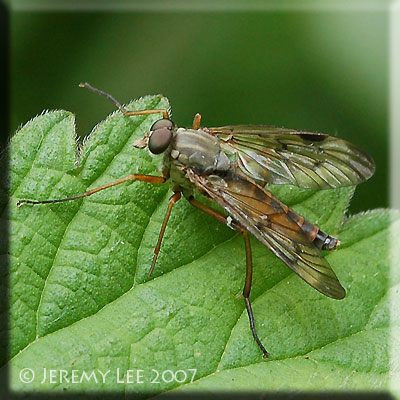
 |
|
Scientific Classifications explained » Amphibians » Ants » Aphids » Bees » Beetles » Birds » Bugs » Butterflies » Caterpillars » Damselflies » Dragonflies » Earwigs » Flies » Frog/Leafhoppers » Fungi » Galls » Grasshoppers » Harvestmen » Hoverflies » Lacewings » Ladybirds » Leaf Mines » Lichens » Mammals » Millipedes » Mosses » Moths » Sawflies » Slugs » Snails » Spiders » Trees » Wasps » Wild Flowers » Woodlice |
UK Nature > Flies > Rhagio scolopaceus

Scientific Name: Rhagio scolopaceus Common Name: Snipe Fly Rhagio scolopaceus, more commonly known as a Snipe Fly, is 8-16 mm in length and like other Rhagio species R. scolopaceus are yellowy-orange (sometimes darkened) flies with long, slender legs. The sides of the thorax are grey as are the tops of the legs. The wing has several darkened marks. The mouthparts are adapted for piercing and many species are haematophagous as adults, while others are predatory on other insects. Snipe flies in the genus Rhagio are sometimes called "down-looker" flies after their habit of perching head-downward on tree trunks. They also like to sit on leaves in moist vegetation, and can be seen in hedgerows and woodland edges. On the wing from May to July. The larvae are also predatory and are mostly terrestrial, although some are aquatic. Common and widespread in the United Kingdom. |
|

https://www.uknature.co.uk is a website dedicated to showing the immense diversity of UK nature and wildlife. Our vast range of habitats, from lowland arable to snow covered mountains, from storm-ravaged coastlines to peaceful inland freshwater lakes and rivers, from dry, sandy heaths to deciduous and coniferous forests, all these habitats contribute to the abundance of UK nature. We have wild birds in huge numbers either residing or visiting our shores (597 recorded species as at July 2013) and we must also not forget the humble back garden with its grass lawns, flower beds filled with nectar rich flowers, shrubs and trees, all designed to attract huge numbers of insects such as bees, moths, butterflies and hoverflies; and finally the small ponds which provide safe havens for frogs, toads, newts and even slow worms and grass snakes. www.uknature.co.uk is the showcase for my personal passion, photographing uknature in all its glory. I sincerely hope you all enjoy the fruits of my labours. This site and all images contained therein is © Jeremy Lee 2004 - 2021. All Rights Reserved. Site design by Jeremy Lee. Site development & IT Support by Stuart Lee. |